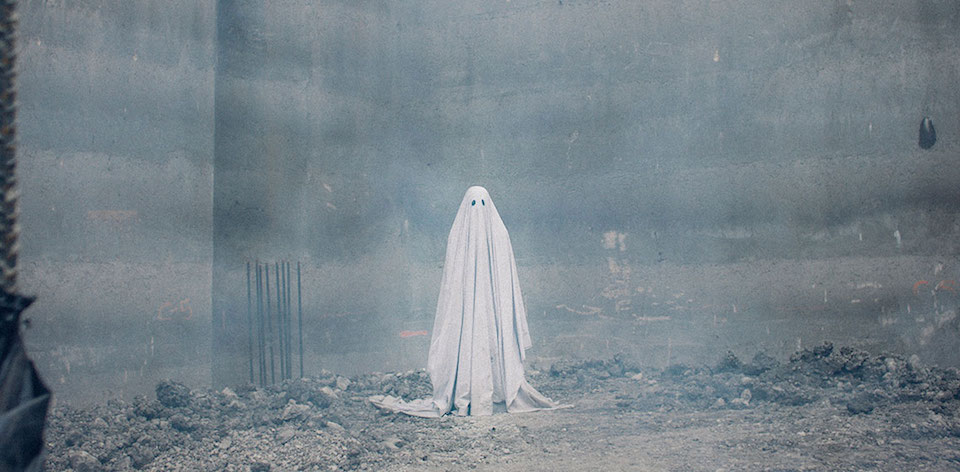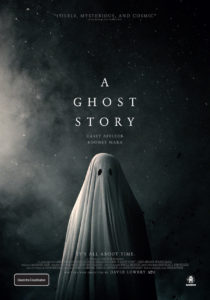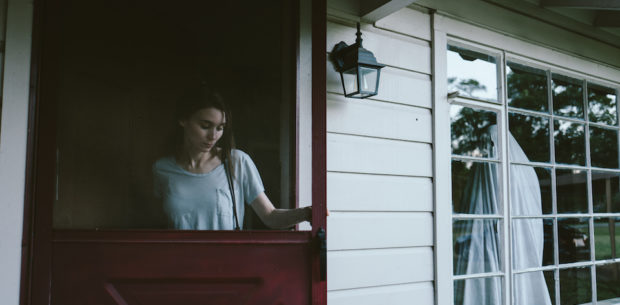You wouldn’t expect the director of Pete’s Dragon to self-finance his next film in secret, but there’s nothing typical about A GHOST STORY. Inspired by the works of Apichatpong Weerasethakul (Uncle Boonmee Who Can Recall His Past Lives), and shot on a micro-budget, writer/director David Lowery’s deeply moving film about grief and connection will haunt you.
Struggling musician C (Casey Affleck) and his wife M (Rooney Mara) live together in a small house. When C is killed in a car crash, he returns home as a spectre covered in a white sheet. As C watches M slowly move on with her life, C slowly finds his own path to closure.
The tagline of A GHOST STORY rather aptly tells us “It’s about time.” This is the literal truth, with Lowery’s experimental structure deftly recreating the relativity of time for audiences. Indeed, there are long stretches where the changing of seasons, or the arrival of some new element, are the only things to suggest that time has passed at all. With the turn of C’s ghostly head, an entire age has gone by. This is the absence of connection writ large, as the world keeps turning around C as he literally stands resolutely still.
In other places, Lowery grinds the passage of time to a halt. A prime example of this is the much talked-about ‘pie scene,’ in which the director stays focused on Mara for a full five minutes as she consumes a pie. In another film, this might be considered indulgent or excessive. Here, we are not just watching someone eat pie to the point of sickness, we are watching someone in pain. Lowery will not let us escape from that, because it is impossible for C to look away at that moment.
As both central figures Kübler-Ross their way through the barebones narrative, A GHOST STORY uses a variety of techniques to suggest dissonance or a floating life. As we pay attention to the most mundane of objects, we may miss noticing the smaller surface area that cinematographer Andrew Droz Palermo has used as his canvas, making effective use of the rounded 4:3 ratio. C, and by extension the audience, might become myopically focused on a single spot on the wall, only to have another part of the house come literally crashing in on him/us.
The combination of Daniel Hart’s aching score and the natural lighting of large empty spaces is post-apocalyptic. Despite this, A GHOST STORY is not traditionally spooky, but it is nevertheless eerie. In fact, the shock of the first moments of C in a sheet might elicit a few nervous giggles. Later in the film, a silent (but subtitled) exchange with another ghost is genuinely funny, reminding us that there are moments of levity in the process of grief. Watching M move on with other men, and other families move into his home, C’s anger is physically manifested on his environment. The audience has context for these moments, and they are less terrifying for us than they are for the characters who confront it.
A GHOST STORY is about permanent impermanence. Only those things that have become solidified in our minds through habit, repetition, and familiarity are truly permanent. C bears witness to this through observing the past, present, and future of something he held onto in life, and his release only comes with the realisation of this. With this film, Lowery gives us a masterclass in how cinema can not only help us better understand time, but also ourselves.
WIND RIVER screened at the Sydney Film Festival 2017. It releases in the US and Australia in August.
[stextbox id=”grey” bgcolor=”F2F2F2″ mleft=”5″ mright=”5″ image=”null”] 2017 | US | DIR: David Lowery | WRITER: David Lowery | CAST: Casey Affleck, Rooney Mara| DISTRIBUTOR: Madman Films (AUS), A24 (US) | RUNNING TIME: 87 minutes | RELEASE DATE: 13 June 2017 (SFF), 7 July 2017 (US), 13 July 2017 (AUS) [/stextbox]
2017 | US | DIR: David Lowery | WRITER: David Lowery | CAST: Casey Affleck, Rooney Mara| DISTRIBUTOR: Madman Films (AUS), A24 (US) | RUNNING TIME: 87 minutes | RELEASE DATE: 13 June 2017 (SFF), 7 July 2017 (US), 13 July 2017 (AUS) [/stextbox]





